HaloPSA
LAST UPDATED: SEP 9, 2025
Overview
HaloPSA (Professional Services Automation) is a cloud-based software platform designed to help Managed Service Providers (MSPs) and IT service businesses manage their operations efficiently. It provides tools to automate workflows, streamline service delivery, and manage client relationships.
D3 SOAR is providing REST operations to function with HaloPSA.
HaloPSA is available for use in:
Known Limitations
500 requests over a 300 second (5 minute) rolling period.
Exceeding the limit will result in an HTTP 429 (too many requests) response and information regarding the specific limit.
Connection
To connect to HaloPSA from D3 SOAR, follow this part to collect the required information below:
Parameter | Description | Example |
Server URL | The URL of the resource server at the domain level obtainable from the HaloPSA UI via Configuration > Integration > HaloPSA API. | https://*****.halopsa.com |
Client ID | The Client ID obtainable from the HaloPSA UI via Configuration > Integrations > HaloPSA API > View Applications. | 5010*****bb8b |
Client Secret | The Client Secret obtainable from the HaloPSA UI via Configuration > Integrations > HaloPSA API > View Applications. | 4210*****a062 |
Permission Requirements
Each endpoint in the HaloPSA API requires a certain permission scope. These are the minimum permission scopes needed for the commands in this integration to return a successful API response.
Command | Required Permissions |
Add Note to Tickets | User: The API caller must have the right to interact with the user entity. |
Assign Tickets | |
Attach File to Ticket | |
Close Tickets | |
Create Actions | |
Create Tickets | |
Delete Tickets |
|
Fetch Event |
|
Generate Ticket Reports | User: The API caller must have the right to interact with the user entity. |
Get Tickets |
|
List Agents | Agent: The API caller must authenticate as an agent account, not just an end user. |
List Categories | |
List Teams | |
List Ticket Areas | |
List Ticket Statuses | |
List Ticket Types | User: The API caller must have the right to interact with the user entity. |
Resolve Tickets | |
Update Tickets | |
Test Connection |
|
READER NOTE
The scopes above do not map directly to specific options in the HaloPSA role configuration UI. Instead, they outline the minimum permissions required for the API to return a 200 response. In practice, non-admin roles may receive only partial data.
For example, the steps below show how to configure a role in HaloPSA with permission to delete any ticket using the Delete Tickets command:
Ticket Access Level → Read and Modify
Can view Unassigned Tickets → Yes
Can view Tickets assigned to other Agents → Yes
Can Delete Tickets → Yes
Can Edit Tickets Not Assigned to Them → Yes
all:standard
all:teams
To limit a user’s ability to run the Delete Tickets command, administrators—who have unrestricted access to all commands—can remove these permissions as needed.
Configuring HaloPSA to Work with D3 SOAR
To integrate HaloPSA with D3 SOAR, users must configure role-based access control, then obtain the the application client ID and secret from the HaloPSA UI.
Creating a Custom Agent Role
Log into HaloPSA as a user with administrator privileges.
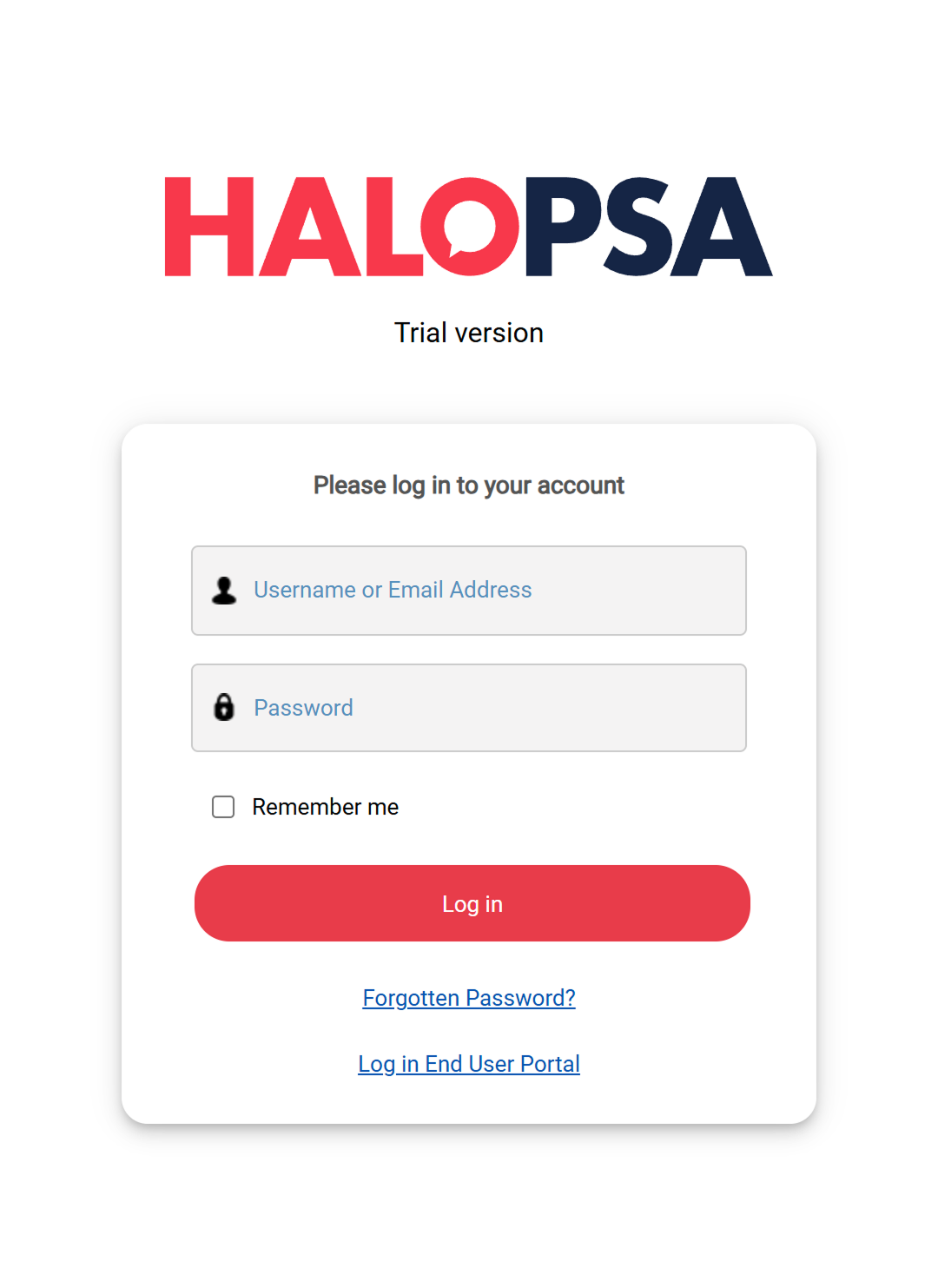
Navigate to Configuration > Teams & Agents > Roles, then click the + New button.
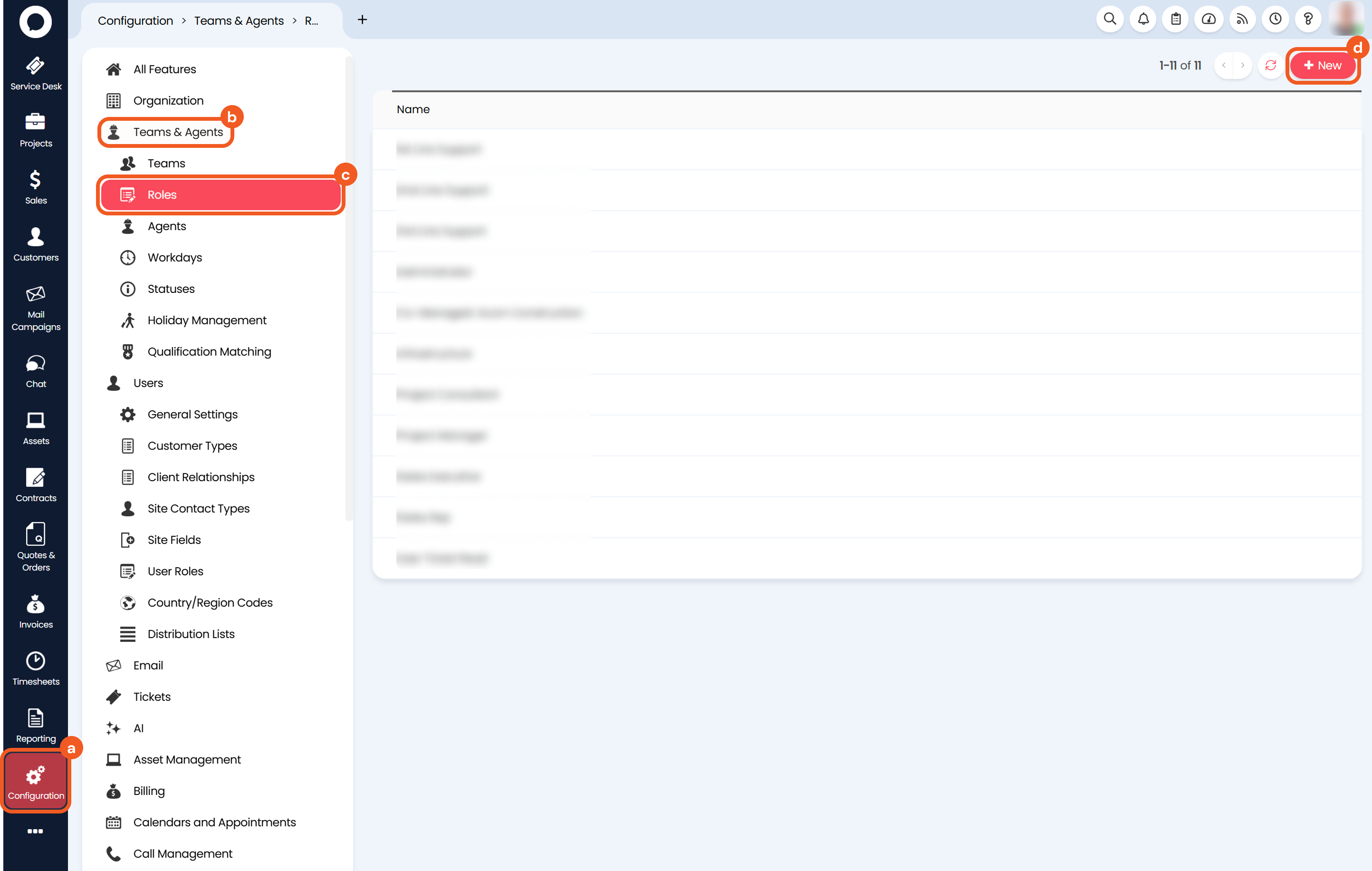
Enter a name for the new agent role, then click the Save button.
.png?inst-v=9d16beaf-952a-4ae4-8fe8-e35f7a3745da)
Click the Edit button, then select the Permissions tab.
.png?inst-v=9d16beaf-952a-4ae4-8fe8-e35f7a3745da)
Choose the desired Agent permissions.
.png?inst-v=9d16beaf-952a-4ae4-8fe8-e35f7a3745da)
Assign this role to an agent, then save.
.png?inst-v=9d16beaf-952a-4ae4-8fe8-e35f7a3745da)
Select the Details tab.
Choose the desired agent to assign the role.
Click the Save button.
Obtaining the Client ID and Client Secret
Navigate to Configuration > Integrations > HaloPSA API.
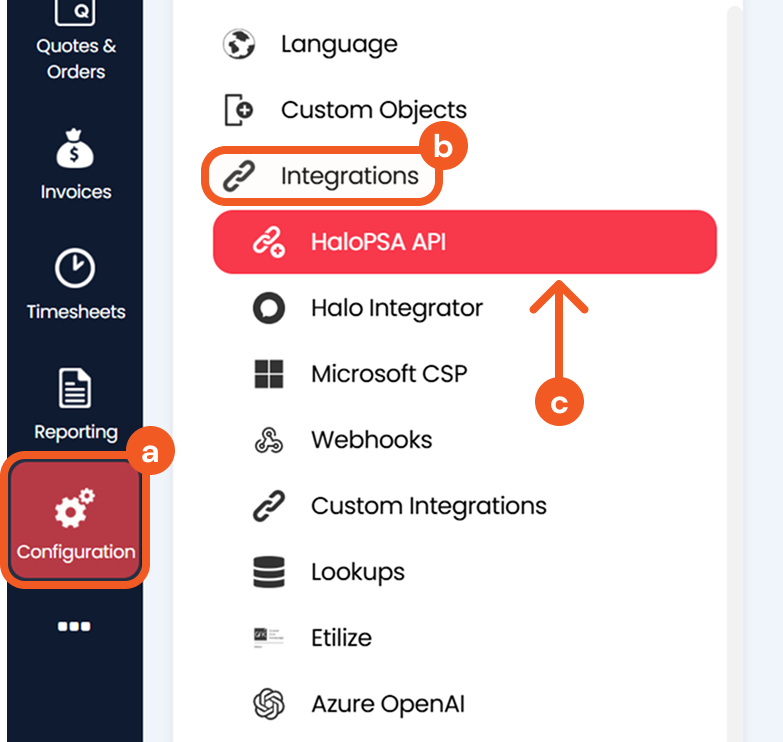
Copy the value from the Resource Server field, excluding the trailing /api (e.g., https://company.halopsa.com). This is the Server URL for the connection.
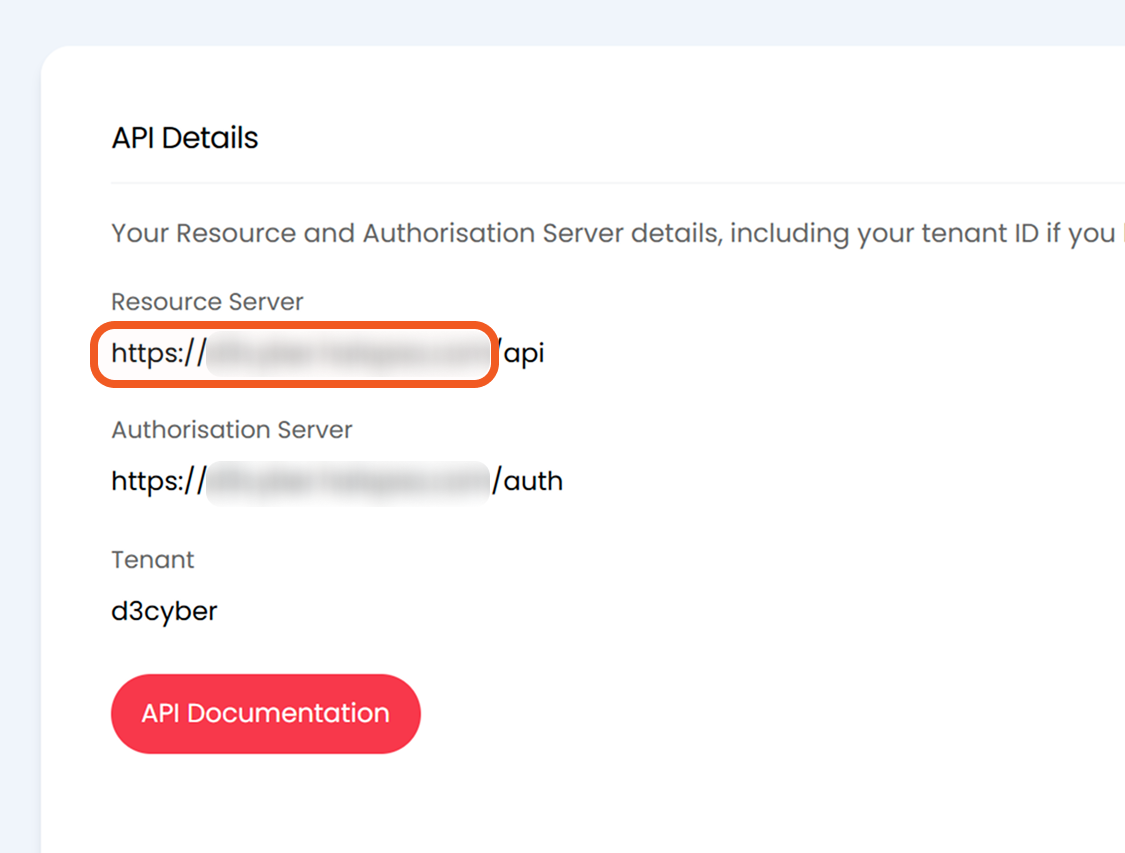
Refer to step 3i, sub-step 1 in Configuring D3 SOAR to Work with HaloPSA.
Click the View Applications button, then click the New button to create a new application.
.png?inst-v=9d16beaf-952a-4ae4-8fe8-e35f7a3745da)
Retrieve the Client Secret.
.png?inst-v=9d16beaf-952a-4ae4-8fe8-e35f7a3745da)
Enter a name for the application.
Select the Client ID and Secret (Services) option.
Click the Copy button to copy the Client Secret. Refer to step 3i, sub-step 3 in Configuring D3 SOAR to Work with HaloPSA.
The Client Secret is displayed only during application creation.
Select the Agent option.
Choose the agent account assigned to the role configured earlier.
Ensure to not copy the Client ID yet as this value will change after selecting permission scopes.
Select the Permissions tab, select the desired Application permissions, then return to the Details tab.
.png?inst-v=9d16beaf-952a-4ae4-8fe8-e35f7a3745da)
Copy the Client ID, then click the Save button.
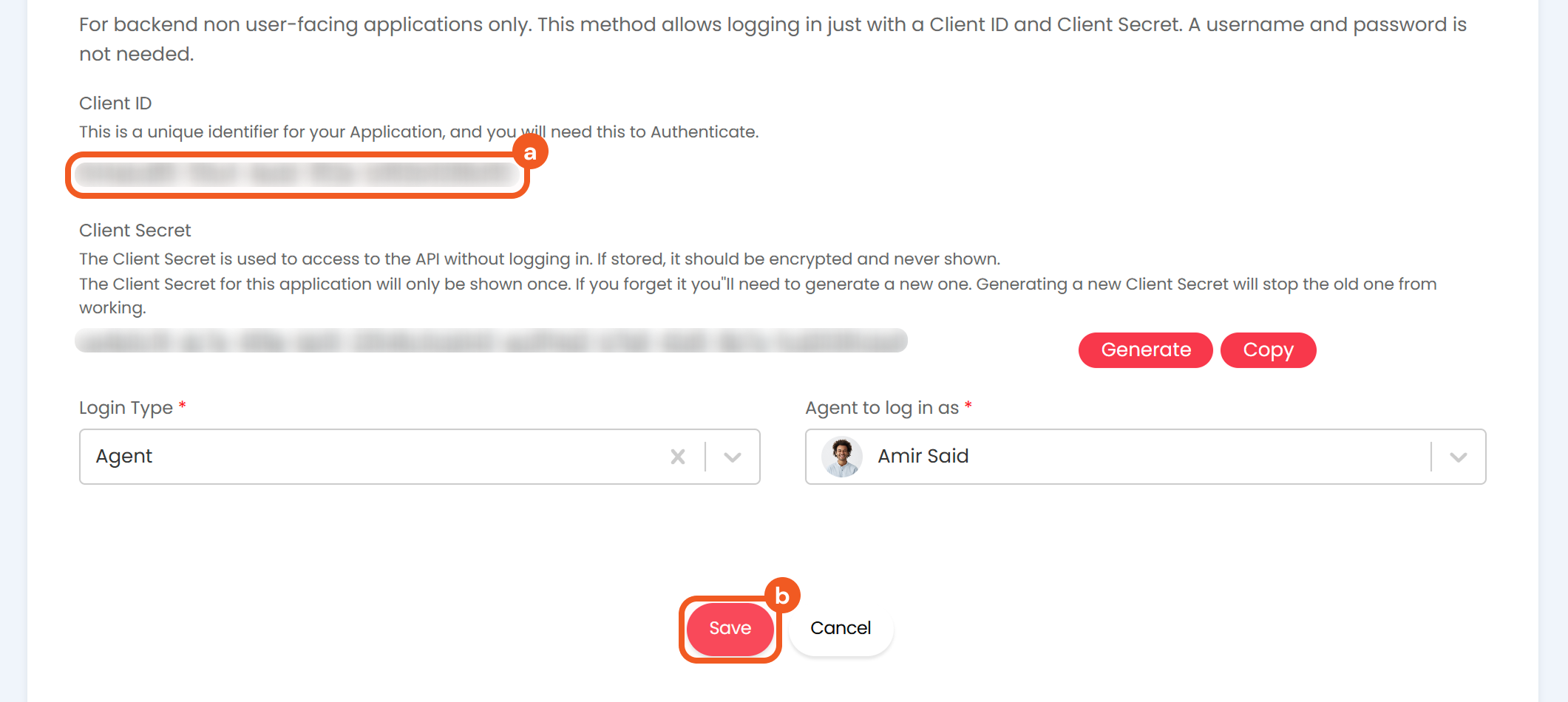
Refer to sub-step 2 under step 3i in Configuring D3 SOAR to Work with HaloPSA.
Configuring D3 SOAR to Work with HaloPSA
Log in to D3 SOAR.
Find the HaloPSA integration.

Navigate to Configuration on the top header menu.
Click on the Integration icon on the left sidebar.
Type HaloPSA in the search box to find the integration, then click it to select it.
Click on the + Connection button on the right side of the Connections section. A new connection window will appear.
Configure the following fields to create a connection to HaloPSA.
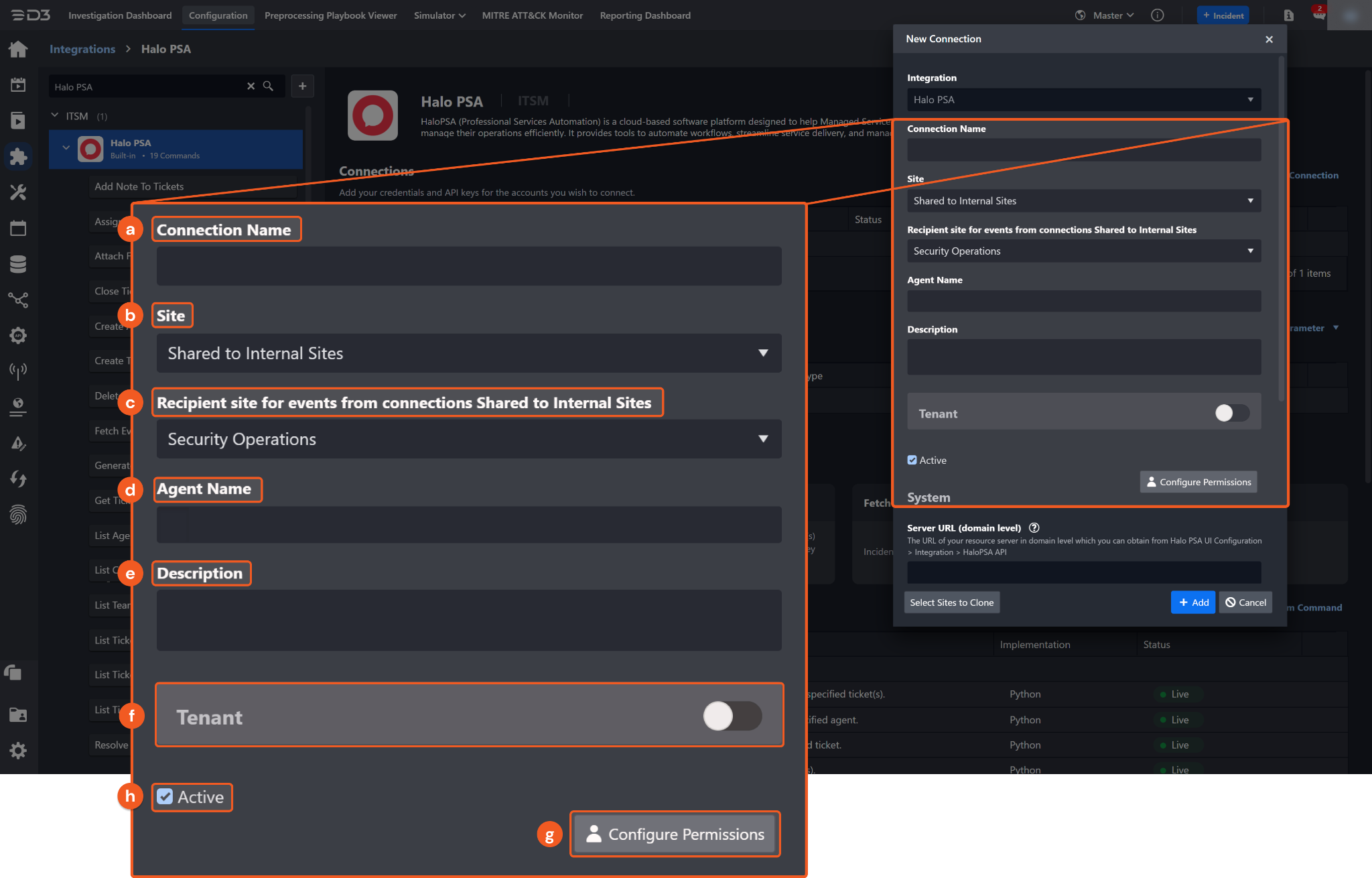
Connection Name: The desired name for the connection.
Site: The site on which to use the integration connection. Use the drop-down menu to select the site. The Share to Internal Sites option enables all internal sites to use the connection. Selecting a specific site will only enable that site to use the connection.
Recipient site for events from connections Shared to Internal Sites: This field is displayed when Share to Internal Sites is selected for the Site field, allowing selection of the internal site for deploying the integration connection.
Agent Name (Optional): The proxy agent required to build the connection. Use the dropdown menu to select the proxy agent from a list of previously configured proxy agents.
Description (Optional): The description for the connection.
Tenant (Optional): When configuring the connection from a master tenant site, users can choose the specific tenant sites with which to share the connection. Once this setting is enabled, users can filter and select the desired tenant sites from the dropdowns to share the connection.
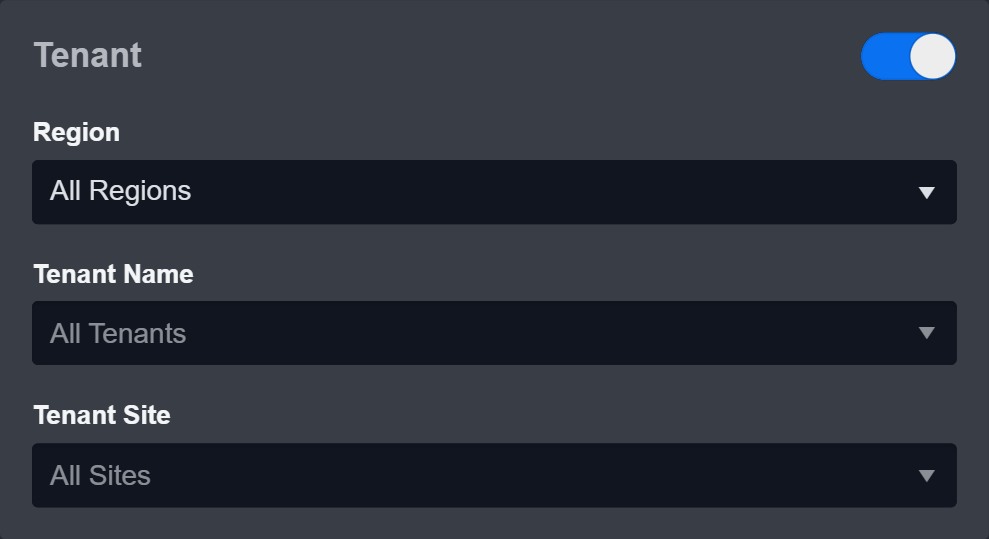
Active: The checkbox that enables the connection to be used when selected.
Configure User Permissions: Defines which users have access to the connection.
System: This section contains the parameters defined specifically for the integration. These parameters must be configured to create the integration connection.
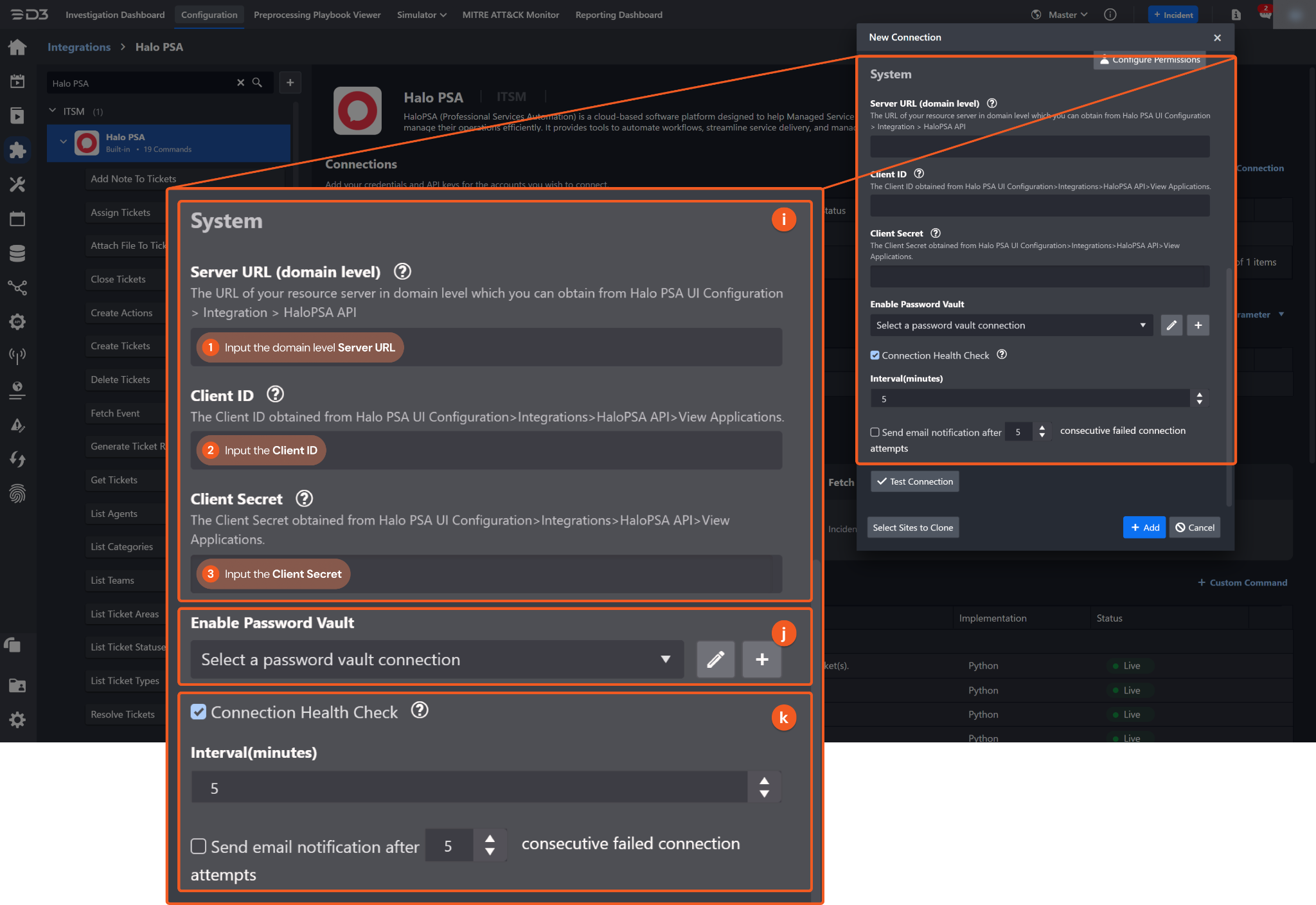
1. Input the Server URL. Refer to step 2 of Obtaining the Client ID and Client Secret.
2. Copy the Client ID from the HaloPSA platform. Refer to step 6 of Obtaining the Client ID and Client Secret.
3. Copy the Client Secret from the HaloPSA platform. Refer to step 4c of Obtaining the Client ID and Client Secret.
Enable Password Vault: An optional feature that allows users to take the stored credentials from their own password vault. Refer to the password vault connection guide if needed.
Connection Health Check: Periodically checks the connection status by scheduling the Test Connection command at the specified interval (in minutes). Available only for active connections, this feature also allows configuring email notifications for failed attempts.
Test the connection.
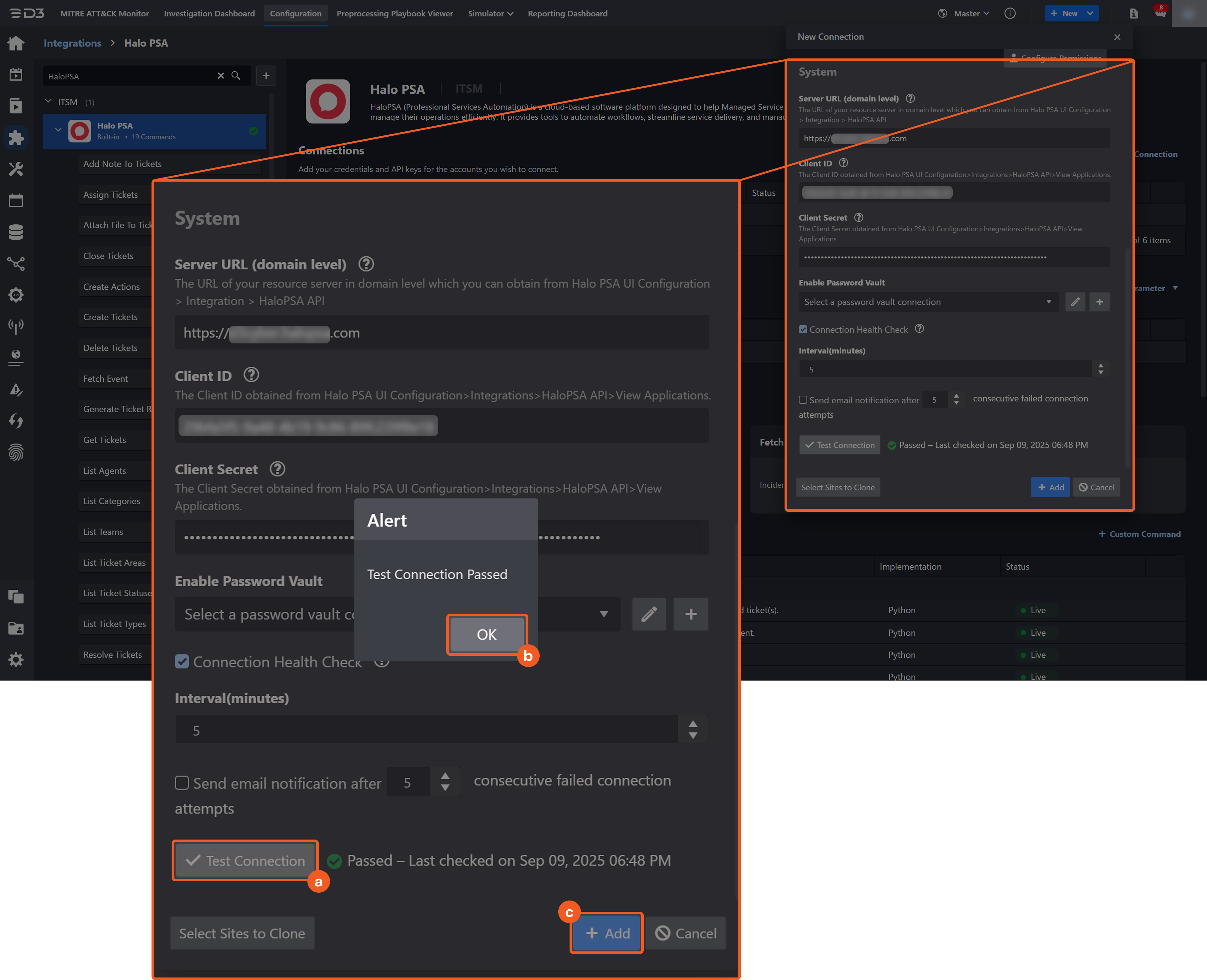
Click on the Test Connection button to verify credentials and connectivity. A success alert displays Passed with a green checkmark. If the connection fails, review the parameters and retry.
Click OK to close the alert window.
Click + Add to create and add the configured connection.
CAUTION
After a permission change, previously issued HaloPSA tokens remain valid for about 9 hours with the old permissions. As a result, commands that require higher permissions will not run successfully until a new connection is created to obtain a fresh token.
Commands
HaloPSA includes the following executable commands for users to set up schedules or create playbook workflows. With the Test Command function, users can execute these commands independently for playbook troubleshooting.
Integration API Note
For more information about the HaloPSA API, refer to the HaloPSA API reference. Users can access the API reference by navigating to Configuration > Integrations > HaloPSA API, then clicking the API Documentation button.
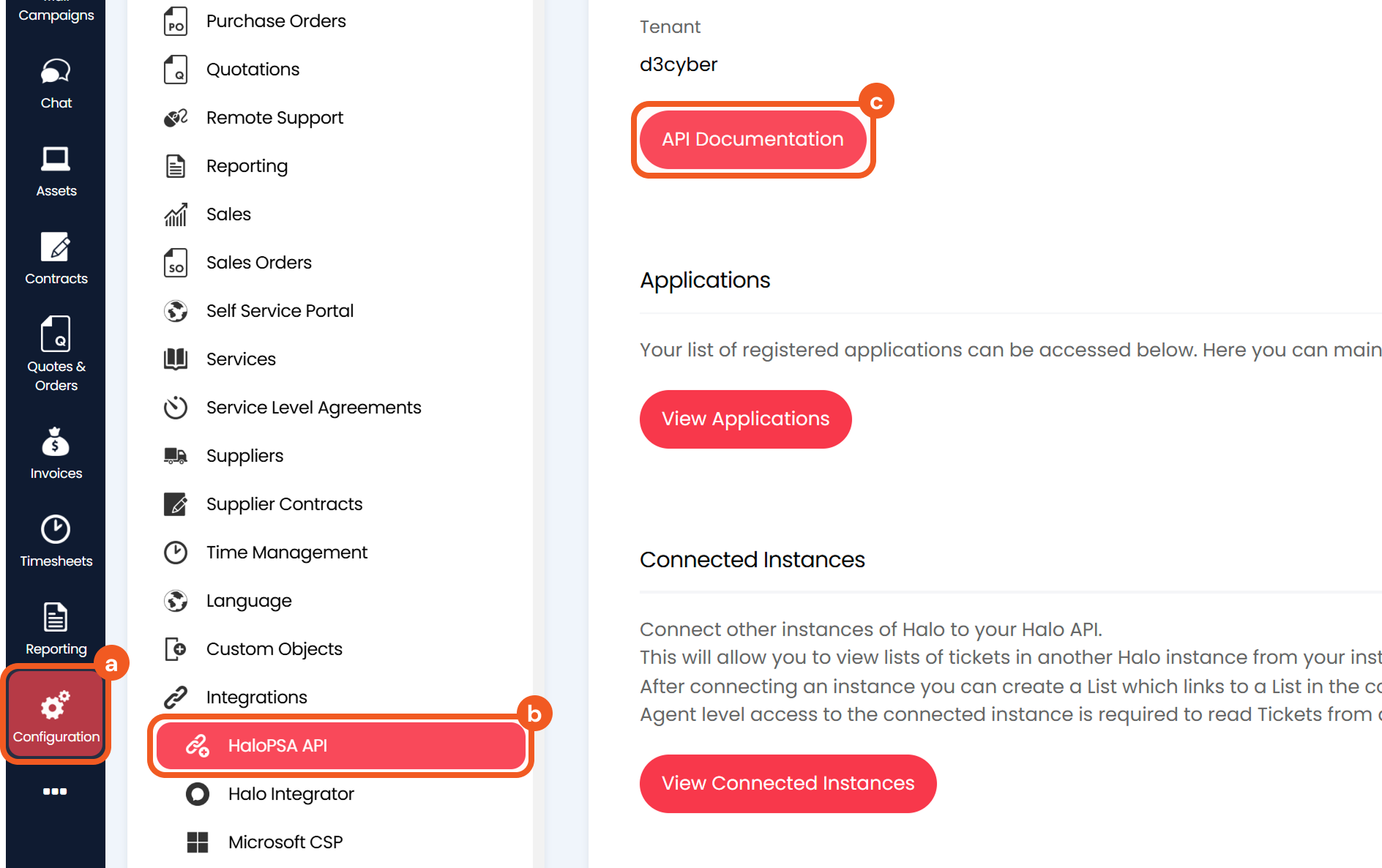
READER NOTE
Certain permissions are required for each command. Refer to the Permission Requirements and Configuring HaloPSA to Work with D3 SOAR sections for details.
Note for Time-related parameters
The input format of time-related parameters may vary based on user account settings, which may cause the sample data in commands to differ from what is displayed. To adjust the time format, follow these steps:
Navigate to Configuration > Application Settings. Select Date/Time Format.
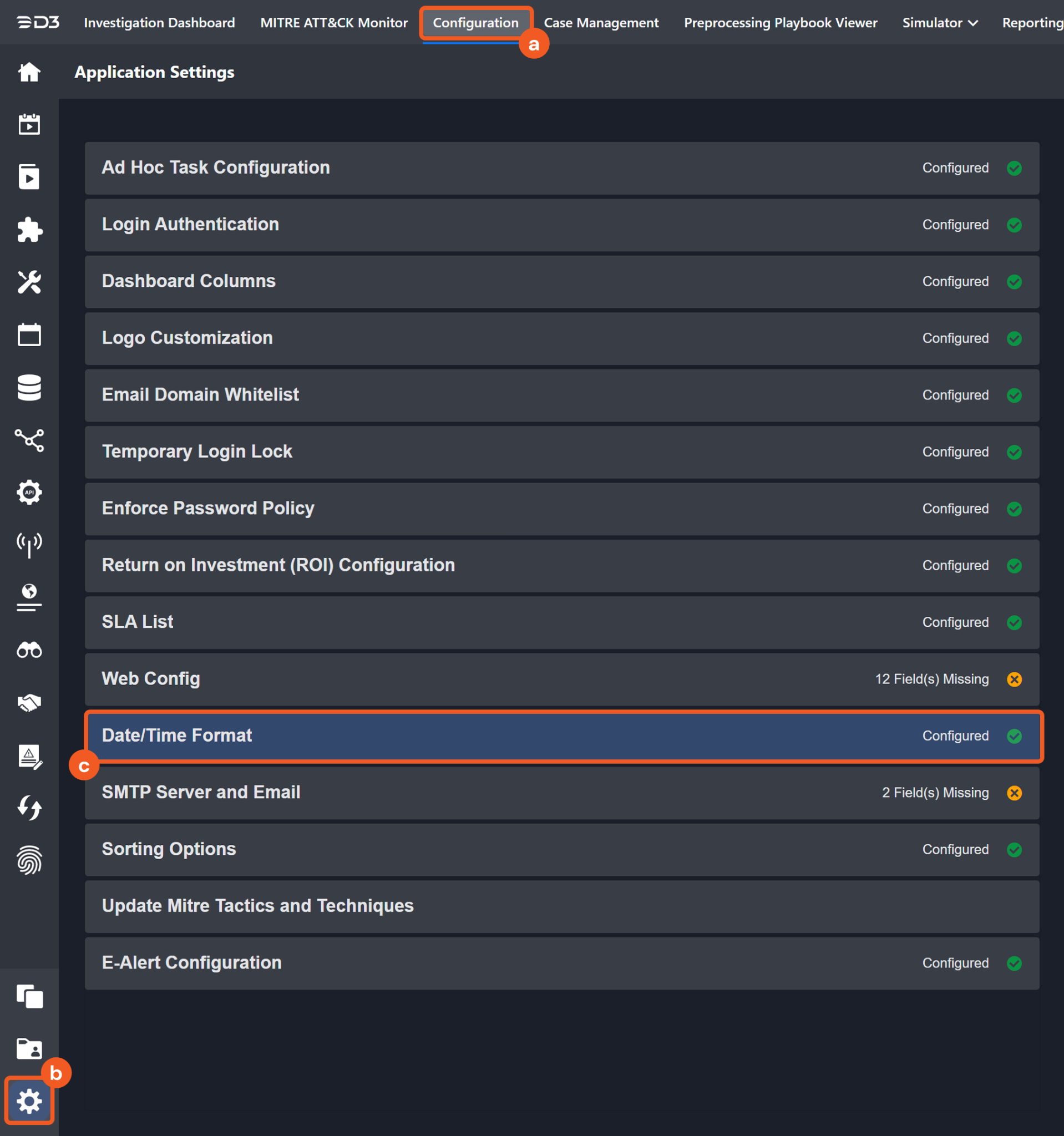
Choose the desired date and time format, then click on the Save button.

The selected time format will now be visible when configuring Date/Time command input parameters.
Add Note to Tickets
Adds a private note to one or more specified tickets.
READER NOTE
Ticket IDs is a required parameter to run this command.
Run the Fetch Event command to obtain the Ticket ID. Ticket IDs can be found in the raw data at the path $.tickets[*].id.
Input
Input Parameter | Required/Optional | Description | Example |
Ticket IDs | Required | The IDs of the tickets to which notes will be added. Ticket IDs can be obtained using the Fetch Event command. |
JSON
|
Private Note | Required | The private note to add to the specified tickets. | Need to keep monitoring |
Output
To view the sample output data for all commands, refer to this article.
Error Handling
If the Return Data displays Partially Successful or Failed, an Error tab will appear in the Test Result window.
The error tab contains the details responded from D3 SOAR or third-party API calls, including Failure Indicator, Status Code, and Message. This can help locate the root cause of a command failure.
Parts in Error | Description | Example |
Failure Indicator | Indicates the command failure that happened at a specific input and/or API call. | Add Note to Tickets failed. |
Status Code | The response code issued by the third-party API server or the D3 SOAR system that can be used to locate the corresponding error category. For example, if the returned status code is 401, the selected connection is unauthorized to run the command. The user or system support would need to check the permission setting in the HaloPSA portal. Refer to the HTTP Status Code Registry for details. | Status Code: 500. |
Message | The raw data or captured key error message from the integration API server about the API request failure. | Message: Internal Server Error. |
Error Sample Data Add Note to Tickets failed. Status Code: 500. Message: Internal Server Error. |
Assign Tickets
Assigns one or more specified tickets to a team, an agent, or both.
READER NOTE
Ticket IDs is a required parameter to run this command.
Run the Fetch Event command to obtain the Ticket ID. Ticket IDs can be found in the raw data at the path $.tickets[*].id.
Input
Input Parameter | Required/Optional | Description | Example |
Ticket IDs | Required | The IDs of the tickets to assign. Ticket IDs can be obtained using the Fetch Event command. |
JSON
|
Team | Optional | The name of the team to assign to the tickets. Team name can be obtained using the List Teams command. Provide Team, Agent ID, or both. | 1st Line Support |
Agent ID | Optional | The ID of the agent to assign to the tickets. Agent ID can be obtained using the List Agents command. Assignment will not occur if the agent does not belong to the specified team. Provide Team, Agent ID, or both. |
JSON
|
Private Note | Optional | The private note to add to the assigned tickets. | reassign ticket to standby |
Output
To view the sample output data for all commands, refer to this article.
Error Handling
If the Return Data displays Partially Successful or Failed, an Error tab will appear in the Test Result window.
The error tab contains the details responded from D3 SOAR or third-party API calls, including Failure Indicator, Status Code, and Message. This can help locate the root cause of a command failure.
Parts in Error | Description | Example |
Failure Indicator | Indicates the command failure that happened at a specific input and/or API call. | Assign Tickets failed. |
Status Code | The response code issued by the third-party API server or the D3 SOAR system that can be used to locate the corresponding error category. For example, if the returned status code is 401, the selected connection is unauthorized to run the command. The user or system support would need to check the permission setting in the HaloPSA portal. Refer to the HTTP Status Code Registry for details. | Status Code: 500. |
Message | The raw data or captured key error message from the integration API server about the API request failure. | Message: Internal Server Error. |
Error Sample Data Assign Tickets failed. Status Code: 500. Message: Internal Server Error. |
Attach File to Ticket
Attaches a file to a specified ticket.
READER NOTE
Ticket IDs is a required parameter to run this command.
Run the Fetch Event command to obtain the Ticket ID. Ticket IDs can be found in the raw data at the path $.tickets[*].id.
File ID and File Source
It is not recommended to use the Test Command feature with the Attach File to Ticket command as it is designed for dynamic input files in Playbooks, Incident Attachments, and Artifact Attachments. There is a simple workaround to test the command:
Navigate to Configuration on the top bar menu.
Click on Utility Commands on the left sidebar menu.
Use the search box to find and select the Create a File from input Text Array command.
Click on the Test tab.
Input the required information for the parameters.
Click on the Test Command button. A D3 File ID will appear in the output data after the file has been successfully created. The D3 File Source of the created file will be Playbook File.
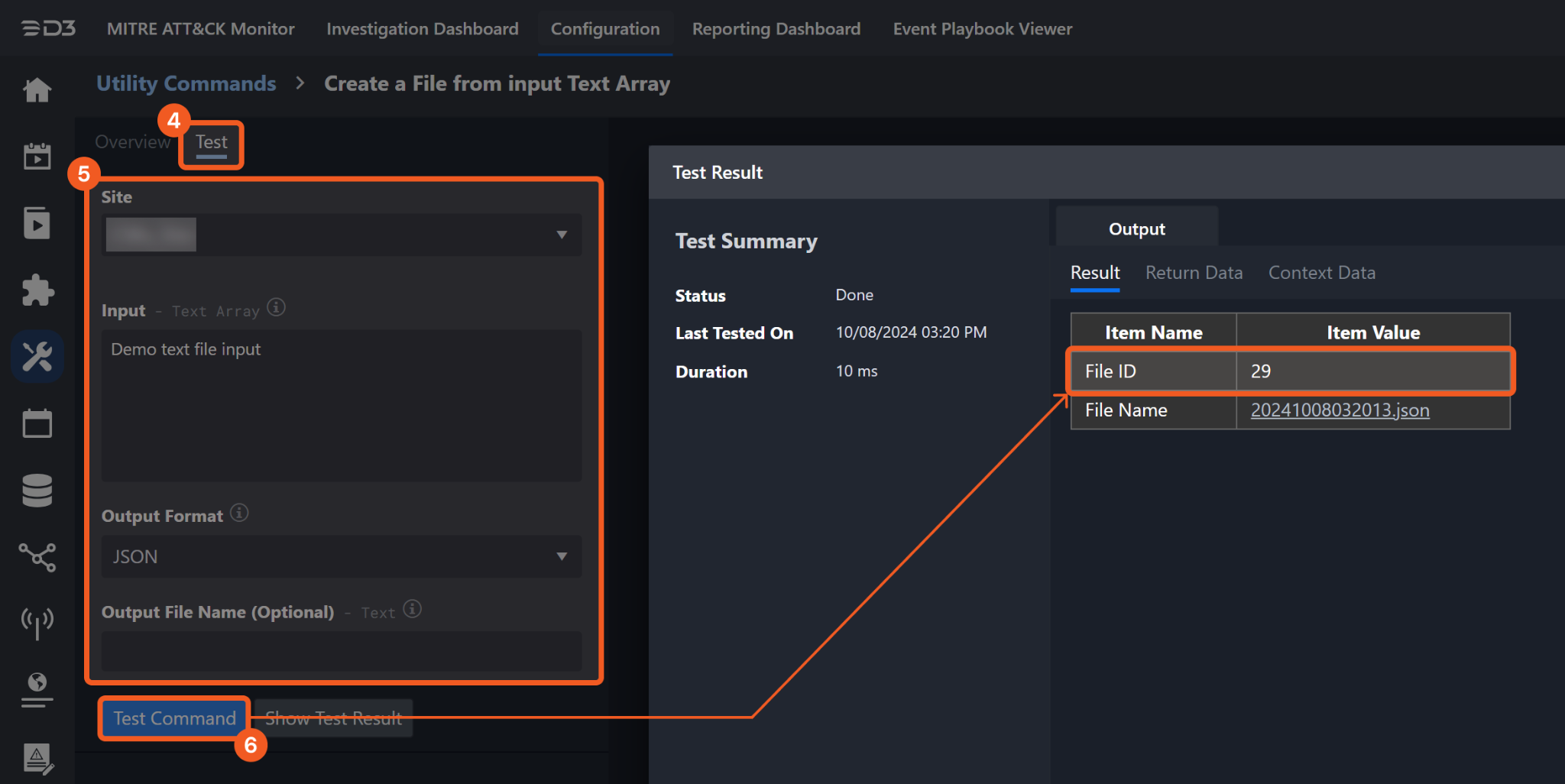
Input
Input Parameter | Required/Optional | Description | Example |
Ticket ID | Required | The ID of the ticket to which the file will be attached. Ticket ID can be obtained using the Fetch Event command. | ***** |
File ID | Required | The D3 File ID of the file to be attached. | ***** |
File Source | Optional | The file source of the D3 file to be attached. The options for file sources are:
| IR Attachment |
Attachment Name | Optional | The display name of the attachment. By default, the file name will be used. | sample code |
Output
To view the sample output data for all commands, refer to this article.
Error Handling
If the Return Data displays Failed, an Error tab will appear in the Test Result window.
The error tab contains the details responded from D3 SOAR or third-party API calls, including Failure Indicator, Status Code, and Message. This can help locate the root cause of a command failure.
Parts in Error | Description | Example |
Failure Indicator | Indicates the command failure that happened at a specific input and/or API call. | Attach File to Ticket failed. |
Status Code | The response code issued by the third-party API server or the D3 SOAR system that can be used to locate the corresponding error category. For example, if the returned status code is 401, the selected connection is unauthorized to run the command. The user or system support would need to check the permission setting in the HaloPSA portal. Refer to the HTTP Status Code Registry for details. | Status Code: 500. |
Message | The raw data or captured key error message from the integration API server about the API request failure. | Message: Internal Server Error. |
Error Sample Data Attach File to Ticket failed. Status Code: 500. Message: Internal Server Error. |
Close Tickets
Closes one or more specified tickets.
READER NOTE
Ticket IDs is a required parameter to run this command.
Run the Fetch Event command to obtain the Ticket ID. Ticket IDs can be found in the raw data at the path $.tickets[*].id.
Input
Input Parameter | Required/Optional | Description | Example |
Ticket IDs | Required | The IDs of the tickets to close. Ticket IDs can be obtained using the Fetch Event command. |
CODE
|
Private Note | Optional | The private note to add when closing the tickets. | Issue was fixed |
Output
To view the sample output data for all commands, refer to this article.
Error Handling
If the Return Data displays Partially Successful or Failed, an Error tab will appear in the Test Result window.
The error tab contains the details responded from D3 SOAR or third-party API calls, including Failure Indicator, Status Code, and Message. This can help locate the root cause of a command failure.
Parts in Error | Description | Example |
Failure Indicator | Indicates the command failure that happened at a specific input and/or API call. | Close Tickets failed. |
Status Code | The response code issued by the third-party API server or the D3 SOAR system that can be used to locate the corresponding error category. For example, if the returned status code is 401, the selected connection is unauthorized to run the command. The user or system support would need to check the permission setting in the HaloPSA portal. Refer to the HTTP Status Code Registry for details. | Status Code: 500. |
Message | The raw data or captured key error message from the integration API server about the API request failure. | Message: Internal Server Error. |
Error Sample Data Close Tickets failed. Status Code: 500. Message: Internal Server Error. |
Create Actions
Creates one or more built-in or custom actions for specified tickets. Use this command to perform actions such as Triage or Claim. Refer to HaloPSA Web UI under Configuration > Tickets > Actions for configuration details.
Input
Input Parameter | Required/Optional | Description | Example |
Action Objects | Required | The JSON array of action objects to create. Each object must include both a ticket ID and either an outcome or an outcome ID. Required fields vary depending on the action type. Refer to HaloPSA Web UI under Configuration > Tickets > Actions for complete requirements. |
JSON
|
Output
To view the sample output data for all commands, refer to this article.
Error Handling
If the Return Data displays Partially Successful or Failed, an Error tab will appear in the Test Result window.
The error tab contains the details responded from D3 SOAR or third-party API calls, including Failure Indicator, Status Code, and Message. This can help locate the root cause of a command failure.
Parts in Error | Description | Example |
Failure Indicator | Indicates the command failure that happened at a specific input and/or API call. | Create Actions failed. |
Status Code | The response code issued by the third-party API server or the D3 SOAR system that can be used to locate the corresponding error category. For example, if the returned status code is 401, the selected connection is unauthorized to run the command. The user or system support would need to check the permission setting in the HaloPSA portal. Refer to the HTTP Status Code Registry for details. | Status Code: 500. |
Message | The raw data or captured key error message from the integration API server about the API request failure. | Message: Internal Server Error. |
Error Sample Data Create Actions failed. Status Code: 500. Message: Internal Server Error. |
Create Tickets
Creates one or more tickets.
Input
Input Parameter | Required/Optional | Description | Example |
Ticket Objects | Required | The tickets to be created in JSON Array. Different ticket types have different required fields. If tickettype_id is unspecified, the default ticket type is Incident. It is recommended that users create a ticket object template, then create new tickets based on it. |
JSON
|
Output
To view the sample output data for all commands, refer to this article.
Error Handling
If the Return Data displays Partially Successful or Failed, an Error tab will appear in the Test Result window.
The error tab contains the details responded from D3 SOAR or third-party API calls, including Failure Indicator, Status Code, and Message. This can help locate the root cause of a command failure.
Parts in Error | Description | Example |
Failure Indicator | Indicates the command failure that happened at a specific input and/or API call. | Create Tickets failed. |
Status Code | The response code issued by the third-party API server or the D3 SOAR system that can be used to locate the corresponding error category. For example, if the returned status code is 401, the selected connection is unauthorized to run the command. The user or system support would need to check the permission setting in the HaloPSA portal. Refer to the HTTP Status Code Registry for details. | Status Code: 500. |
Message | The raw data or captured key error message from the integration API server about the API request failure. | Message: Internal Server Error. |
Error Sample Data Create Tickets failed. Status Code: 500. Message: Internal Server Error. |
Delete Tickets
Deletes the specified tickets by ticket IDs.
READER NOTE
Ticket IDs is a required parameter to run this command.
Run the Fetch Event command to obtain the Ticket ID. Ticket IDs can be found in the raw data at the path $.tickets[*].id.
Input
Input Parameter | Required/Optional | Description | Example |
Ticket IDs | Required | The IDs of the tickets to delete. Ticket IDs can be obtained using the Fetch Event command. |
JSON
|
Reason | Optional | The reason for deleting the tickets. | Duplicate ticket |
Output
To view the sample output data for all commands, refer to this article.
Error Handling
If the Return Data displays Partially Successful or Failed, an Error tab will appear in the Test Result window.
The error tab contains the details responded from D3 SOAR or third-party API calls, including Failure Indicator, Status Code, and Message. This can help locate the root cause of a command failure.
Parts in Error | Description | Example |
Failure Indicator | Indicates the command failure that happened at a specific input and/or API call. | Delete Tickets failed. |
Status Code | The response code issued by the third-party API server or the D3 SOAR system that can be used to locate the corresponding error category. For example, if the returned status code is 401, the selected connection is unauthorized to run the command. The user or system support would need to check the permission setting in the HaloPSA portal. Refer to the HTTP Status Code Registry for details. | Status Code: 500. |
Message | The raw data or captured key error message from the integration API server about the API request failure. | Message: Internal Server Error. |
Error Sample Data Delete Tickets failed. Status Code: 500. Message: Internal Server Error. |
Fetch Event
Returns tickets as Events from the HaloPSA based on specified filter criteria. Tickets are sorted by last updated time in descending order.
READER NOTE
Ticket Types, Statuses, and Ticket Areas are optional parameters to run this command.
Run the List Ticket Types command to obtain the Ticket Types. Ticket Types can be found in the raw data at $.Results[*].id.
Run the List Ticket Statuses command to obtain the Statuses. Statuses can be found in the raw data at $.Results[*].id.
Run the List Ticket Areas command to obtain the Ticket Areas. Ticket Areas can be found in the raw data at $.Results[*].id.
Input
Input Parameter | Required/Optional | Description | Example |
Start Time | Optional | The start time (in UTC) for the time range used to filter tickets by last updated time. By default, the value is 24 hours before the End Time. | 2024-12-18 23:03:34 |
End Time | Optional | The end time (in UTC) for the time range used to filter tickets by last updated time. By default, the value is the current time. | 2024-12-19 23:03:34 |
Number of Event(s) Fetched | Optional | The maximum number of the most recently updated tickets to return. Accepted values range from 1 to 1000. Returning a large number of tickets may impact system performance. By default, all tickets matching the filters will be retrieved. | 10 |
Ticket Types | Optional | The ticket type IDs used to filter results. Ticket Types can be obtained using the List Ticket Types command. For example, to ingest Incident tickets only, input [ 1 ]. By default, all tickets regardless of their type are returned. |
JSON
|
Statuses | Optional | The ticket status IDs used to filter tickets. Statuses can be obtained using the List Ticket Statuses command. For example, to ingest tickets with the New and In Progress statuses only, input [ 1,2 ]. By default, all tickets are returned regardless of their status. |
JSON
|
Ticket Areas | Optional | The ticket area IDs used to filter tickets. Ticket Areas can be obtained using the List Ticket Areas command. For example, to ingest tickets in the Service Desk area only, input [ 1 ]. By default, all tickets are returned regardless of their area. |
JSON
|
Search String | Optional | The search string used to filter tickets by their summary. | 1218 new ticket |
Additional Parameters | Optional | Any parameters in addition to the provided ones used to refine the filtering logic. |
JSON
|
Output
To view the sample output data for all commands, refer to this article.
Fetch Event Field Mapping
Fetch Event commands require event field mapping. Field mapping plays a key role for data normalization within the event pipeline. Field mapping converts the original data fields from the different providers to standardized D3 fields as defined by the D3 Model. Refer to Field Mappings for details.
To add a custom field, click on the + Add Field button. Users can also remove built-in field mappings by clicking x. Note that two underscore characters will automatically prefix the defined Field Name as the System Name for a custom field mapping. Additionally, if an input Field Name contains any spaces, they will automatically be replaced with underscores for the corresponding System Name.
As a system integration, the HaloPSA integration has some pre-configured field mappings for default field mapping.
Default Event Source
The Default Event Source is the default set of field mappings that are applied when this fetch event command is executed. For out-of-the-box integrations, users will find a set of field mappings provided by the system. Default event source provides field mappings for common fields from the fetched data. The default event source has a "Main Event JSON Path" (i.e. $.tickets) that is used to extract a batch of events from the response raw data. View the "Main Event JSON Path" by clicking on the Edit Main JSON Path button.
.png?inst-v=9d16beaf-952a-4ae4-8fe8-e35f7a3745da)
Main Event JSON Path: $.tickets
The Main Event JSON Path determines the root path where the system starts parsing raw response data into D3 event data. The JSON path begins with $, representing the root element. The path is formed by appending a sequence of child elements to $, each separated by a dot (.). Square brackets with nested quotation marks ([‘...’]) should be used to separate child elements in JSON arrays.
For example, the root node of a JSON Path is tickets. The child node denoting the Event Type field would be tickettype_name. Putting it together, the JSON Path expression to extract the Event Type is $.tickets.tickettype_name.
The pre-configured field mappings are detailed below:
Field Name | Source Field |
Document ID | .id |
Start Time | .dateoccurred |
Description | .summary |
Details | .details |
Event Type | .tickettype_name |
Priority | .priority_id |
Impact | .impact |
Urgency | .urgency |
Status | .status_name |
Client Name | .client_name |
Site Name | .site_name |
Event category | .category_1 |
Username | .user_name |
Agent Name | .agent_name |
Tag | .ticket_tags |
Team Name | .team |
Service Category | .related_service_category_names |
Last Action Time | .lastactiondate |
Location | .location.name |
Department | .department.name |
SLA | .sla_id |
Error Handling
If the Return Data displays Failed, an Error tab will appear in the Test Result window.
The error tab contains the details responded from D3 SOAR or third-party API calls, including Failure Indicator, Status Code, and Message. This can help locate the root cause of a command failure.
Parts in Error | Description | Example |
Failure Indicator | Indicates the command failure that happened at a specific input and/or API call. | Fetch Event failed. |
Status Code | The response code issued by the third-party API server or the D3 SOAR system that can be used to locate the corresponding error category. For example, if the returned status code is 401, the selected connection is unauthorized to run the command. The user or system support would need to check the permission setting in the HaloPSA portal. Refer to the HTTP Status Code Registry for details. | Status Code: 500. |
Message | The raw data or captured key error message from the integration API server about the API request failure. | Message: Internal Server Error. |
Error Sample Data Fetch Event failed. Status Code: 500. Message: Internal Server Error. |
Generate Ticket Reports
Generates reports for one or more specified tickets.
READER NOTE
Ticket IDs is a required parameter to run this command.
Run the Fetch Event command to obtain the Ticket ID. Ticket IDs can be found in the raw data at the path $.tickets[*].id.
Input
Input Parameter | Required/Optional | Description | Example |
Ticket IDs | Required | The IDs of the tickets for which to generate reports. Ticket IDs can be obtained using the Fetch Event command. |
JSON
|
Output
To view the sample output data for all commands, refer to this article.
Error Handling
If the Return Data displays Partially Successful or Failed, an Error tab will appear in the Test Result window.
The error tab contains the details responded from D3 SOAR or third-party API calls, including Failure Indicator, Status Code, and Message. This can help locate the root cause of a command failure.
Parts in Error | Description | Example |
Failure Indicator | Indicates the command failure that happened at a specific input and/or API call. | Generate Ticket Reports failed. |
Status Code | The response code issued by the third-party API server or the D3 SOAR system that can be used to locate the corresponding error category. For example, if the returned status code is 401, the selected connection is unauthorized to run the command. The user or system support would need to check the permission setting in the HaloPSA portal. Refer to the HTTP Status Code Registry for details. | Status Code: 500. |
Message | The raw data or captured key error message from the integration API server about the API request failure. | Message: Internal Server Error. |
Error Sample Data Generate Ticket Reports failed. Status Code: 500. Message: Internal Server Error. |
Get Tickets
Retrieves tickets by ticket IDs.
READER NOTE
Ticket IDs is a required parameter to run this command.
Run the Fetch Event command to obtain the Ticket ID. Ticket IDs can be found in the raw data at the path $.tickets[*].id.
Input
Input Parameter | Required/Optional | Description | Example |
Ticket IDs | Required | The IDs of the tickets for which to retrieve details. Ticket IDs can be obtained using the Fetch Event command. |
JSON
|
Include Details | Optional | Whether to include additional objects in the response data. By default, the value is False. | True |
Output
To view the sample output data for all commands, refer to this article.
Error Handling
If the Return Data displays Partially Successful or Failed, an Error tab will appear in the Test Result window.
The error tab contains the details responded from D3 SOAR or third-party API calls, including Failure Indicator, Status Code, and Message. This can help locate the root cause of a command failure.
Parts in Error | Description | Example |
Failure Indicator | Indicates the command failure that happened at a specific input and/or API call. | Get Tickets failed. |
Status Code | The response code issued by the third-party API server or the D3 SOAR system that can be used to locate the corresponding error category. For example, if the returned status code is 401, the selected connection is unauthorized to run the command. The user or system support would need to check the permission setting in the HaloPSA portal. Refer to the HTTP Status Code Registry for details. | Status Code: 500. |
Message | The raw data or captured key error message from the integration API server about the API request failure. | Message: Internal Server Error. |
Error Sample Data Get Tickets failed. Status Code: 500. Message: Internal Server Error. |
List Agents
Returns a list of agents.
READER NOTE
Team is an optional parameter to run this command.
Run the List Teams command to obtain the Team. Teams can be found in the raw data at the path $.Results[*].name.
Input
Input Parameter | Required/Optional | Description | Example |
Search Agent | Optional | The name, email address, or phone number used to filter agents. | Ken Yang |
Team | Optional | The team name used to filter agents. Team can be obtained using the List Teams command. | 3rd line support |
Output
To view the sample output data for all commands, refer to this article.
Error Handling
If the Return Data displays Failed, an Error tab will appear in the Test Result window.
The error tab contains the details responded from D3 SOAR or third-party API calls, including Failure Indicator, Status Code, and Message. This can help locate the root cause of a command failure.
Parts in Error | Description | Example |
Failure Indicator | Indicates the command failure that happened at a specific input and/or API call. | List Agents failed. |
Status Code | The response code issued by the third-party API server or the D3 SOAR system that can be used to locate the corresponding error category. For example, if the returned status code is 401, the selected connection is unauthorized to run the command. The user or system support would need to check the permission setting in the HaloPSA portal. Refer to the HTTP Status Code Registry for details. | Status Code: 500. |
Message | The raw data or captured key error message from the integration API server about the API request failure. | Message: Internal Server Error. |
Error Sample Data List Agents failed. Status Code: 500. Message: Internal Server Error. |
List Categories
Returns a list of category details.
Input
Input Parameter | Required/Optional | Description | Example |
Team Name | Optional | The name of the team used to filter categories. This parameter is valid only when a Category Type ID is provided. | 3rd line support |
Category Type ID | Optional | The category type ID used to filter results. Input 2 to retrieve the ticket resolution code. | 2 |
Output
To view the sample output data for all commands, refer to this article.
Error Handling
If the Return Data displays Failed, an Error tab will appear in the Test Result window.
The error tab contains the details responded from D3 SOAR or third-party API calls, including Failure Indicator, Status Code, and Message. This can help locate the root cause of a command failure.
Parts in Error | Description | Example |
Failure Indicator | Indicates the command failure that happened at a specific input and/or API call. | List Categories failed. |
Status Code | The response code issued by the third-party API server or the D3 SOAR system that can be used to locate the corresponding error category. For example, if the returned status code is 401, the selected connection is unauthorized to run the command. The user or system support would need to check the permission setting in the HaloPSA portal. Refer to the HTTP Status Code Registry for details. | Status Code: 500. |
Message | The raw data or captured key error message from the integration API server about the API request failure. | Message: Internal Server Error. |
Error Sample Data List Categories failed. Status Code: 500. Message: Internal Server Error. |
List Teams
Returns a list of teams.
Input
Input Parameter | Required/Optional | Description | Example |
Team Names | Optional | The team names used to filter agents. By default, no agents are returned. |
JSON
|
Team Type | Optional | The domain used to filter teams. Available options are:
By default, all teams are returned regardless of their domain. | Tickets |
Department ID | Optional | The department ID used to filter teams belonging to that department. | 3 |
Output
To view the sample output data for all commands, refer to this article.
Error Handling
If the Return Data displays Failed, an Error tab will appear in the Test Result window.
The error tab contains the details responded from D3 SOAR or third-party API calls, including Failure Indicator, Status Code, and Message. This can help locate the root cause of a command failure.
Parts in Error | Description | Example |
Failure Indicator | Indicates the command failure that happened at a specific input and/or API call. | List Teams failed. |
Status Code | The response code issued by the third-party API server or the D3 SOAR system that can be used to locate the corresponding error category. For example, if the returned status code is 401, the selected connection is unauthorized to run the command. The user or system support would need to check the permission setting in the HaloPSA portal. Refer to the HTTP Status Code Registry for details. | Status Code: 500. |
Message | The raw data or captured key error message from the integration API server about the API request failure. | Message: Internal Server Error. |
Error Sample Data List Teams failed. Status Code: 500. Message: Internal Server Error. |
List Ticket Areas
Returns a list of ticket areas.
Input
N/A
Output
To view the sample output data for all commands, refer to this article.
Error Handling
If the Return Data displays Partially Successful or Failed, an Error tab will appear in the Test Result window.
The error tab contains the details responded from D3 SOAR or third-party API calls, including Failure Indicator, Status Code, and Message. This can help locate the root cause of a command failure.
Parts in Error | Description | Example |
Failure Indicator | Indicates the command failure that happened at a specific input and/or API call. | List Ticket Areas failed. |
Status Code | The response code issued by the third-party API server or the D3 SOAR system that can be used to locate the corresponding error category. For example, if the returned status code is 401, the selected connection is unauthorized to run the command. The user or system support would need to check the permission setting in the HaloPSA portal. Refer to the HTTP Status Code Registry for details. | Status Code: 500. |
Message | The raw data or captured key error message from the integration API server about the API request failure. | Message: Internal Server Error. |
Error Sample Data List Ticket Areas failed. Status Code: 500. Message: Internal Server Error. |
List Ticket Statuses
Returns a list of ticket statuses.
Input
N/A
Output
To view the sample output data for all commands, refer to this article.
Error Handling
If the Return Data displays Failed, an Error tab will appear in the Test Result window.
The error tab contains the details responded from D3 SOAR or third-party API calls, including Failure Indicator, Status Code, and Message. This can help locate the root cause of a command failure.
Parts in Error | Description | Example |
Failure Indicator | Indicates the command failure that happened at a specific input and/or API call. | List Ticket Statuses failed. |
Status Code | The response code issued by the third-party API server or the D3 SOAR system that can be used to locate the corresponding error category. For example, if the returned status code is 401, the selected connection is unauthorized to run the command. The user or system support would need to check the permission setting in the HaloPSA portal. Refer to the HTTP Status Code Registry for details. | Status Code: 500. |
Message | The raw data or captured key error message from the integration API server about the API request failure. | Message: Internal Server Error. |
Error Sample Data List Ticket Statuses failed. Status Code: 500. Message: Internal Server Error. |
List Ticket Types
Returns a list of ticket types.
Input
Input Parameter | Required/Optional | Description | Example |
Domain | Optional | The domain used to filter ticket types. Available options are:
By default, all ticket types are returned regardless of their domain. | Tickets |
Output
To view the sample output data for all commands, refer to this article.
Error Handling
If the Return Data displays Failed, an Error tab will appear in the Test Result window.
The error tab contains the details responded from D3 SOAR or third-party API calls, including Failure Indicator, Status Code, and Message. This can help locate the root cause of a command failure.
Parts in Error | Description | Example |
Failure Indicator | Indicates the command failure that happened at a specific input and/or API call. | List Ticket Types failed. |
Status Code | The response code issued by the third-party API server or the D3 SOAR system that can be used to locate the corresponding error category. For example, if the returned status code is 401, the selected connection is unauthorized to run the command. The user or system support would need to check the permission setting in the HaloPSA portal. Refer to the HTTP Status Code Registry for details. | Status Code: 500. |
Message | The raw data or captured key error message from the integration API server about the API request failure. | Message: Internal Server Error. |
Error Sample Data List Ticket Types failed. Status Code: 500. Message: Internal Server Error. |
Resolve Tickets
Resolves one or more specified tickets.
READER NOTE
Ticket IDs is a required parameter to run this command.
Run the Fetch Event command to obtain the Ticket ID. Ticket IDs can be found in the raw data at the path $.tickets[*].id.
Input
Input Parameter | Required/Optional | Description | Example |
Ticket IDs | Required | The IDs of the tickets to resolve. Ticket IDs can be obtained using the Fetch Event command. |
JSON
|
Email To | Required | The email addresses to notify upon ticket resolution. |
JSON
|
Private Note | Optional | The private note to add when resolving the tickets | Issue was fixed |
Additional Fields | Optional | Any additional fields to include in the resolution action. |
JSON
|
Output
To view the sample output data for all commands, refer to this article.
Error Handling
If the Return Data displays Partially Successful or Failed, an Error tab will appear in the Test Result window.
The error tab contains the details responded from D3 SOAR or third-party API calls, including Failure Indicator, Status Code, and Message. This can help locate the root cause of a command failure.
Parts in Error | Description | Example |
Failure Indicator | Indicates the command failure that happened at a specific input and/or API call. | Resolve Tickets failed. |
Status Code | The response code issued by the third-party API server or the D3 SOAR system that can be used to locate the corresponding error category. For example, if the returned status code is 401, the selected connection is unauthorized to run the command. The user or system support would need to check the permission setting in the HaloPSA portal. Refer to the HTTP Status Code Registry for details. | Status Code: 500. |
Message | The raw data or captured key error message from the integration API server about the API request failure. | Message: Internal Server Error. |
Error Sample Data Resolve Tickets failed. Status Code: 500. Message: Internal Server Error. |
Update Tickets
Updates one or more specified tickets.
READER NOTE
Ticket IDs is a required parameter to run this command.
Run the Fetch Event command to obtain the Ticket ID. Ticket IDs can be found in the raw data at the path $.tickets[*].id.
Input
Input Parameter | Required/Optional | Description | Example |
Ticket IDs | Required | The IDs of the tickets to update. Ticket IDs can be obtained using the Fetch Event command. |
JSON
|
Update Ticket Object | Required | The JSON object containing field-value pairs to update. Ensure to only specify field-value pairs that need to be updated. The same object is applied to all specified Ticket IDs. |
JSON
|
Output
To view the sample output data for all commands, refer to this article.
Error Handling
If the Return Data displays Partially Successful or Failed, an Error tab will appear in the Test Result window.
The error tab contains the details responded from D3 SOAR or third-party API calls, including Failure Indicator, Status Code, and Message. This can help locate the root cause of a command failure.
Parts in Error | Description | Example |
Failure Indicator | Indicates the command failure that happened at a specific input and/or API call. | Update Tickets failed. |
Status Code | The response code issued by the third-party API server or the D3 SOAR system that can be used to locate the corresponding error category. For example, if the returned status code is 401, the selected connection is unauthorized to run the command. The user or system support would need to check the permission setting in the HaloPSA portal. Refer to the HTTP Status Code Registry for details. | Status Code: 500. |
Message | The raw data or captured key error message from the integration API server about the API request failure. | Message: Internal Server Error. |
Error Sample Data Update Tickets failed. Status Code: 500. Message: Internal Server Error. |
Test Connection
Allows users to perform a health check on an integration connection. Users can schedule a periodic health check by selecting Connection Health Check when editing an integration connection.
Input
N/A
Output
Output Type | Description | Return Data Type |
Return Data | Indicates one of the possible command execution states: Successful or Failed. The Failed state can be triggered by any of the following errors:
More details about an error can be viewed in the Error tab. | String |
Error Handling
If the Return Data displays Failed, an Error tab will appear in the Test Result window.
The error tab contains the details responded from D3 SOAR or third-party API calls, including Failure Indicator, Status Code, and Message. This can help locate the root cause of a command failure.
Parts in Error | Description | Example |
Failure Indicator | Indicates the command failure that happened at a specific input and/or API call. | Test Connection failed. Failed to check the connector. |
Status Code | The response code issued by the third-party API server or the D3 SOAR system that can be used to locate the corresponding error category. For example, if the returned status code is 401, the selected connection is unauthorized to run the command. The user or system support would need to check the permission setting in the HaloPSA portal. Refer to the HTTP Status Code Registry for details. | Status Code: 500. |
Message | The raw data or captured key error message from the integration API server about the API request failure. | Message: Internal Server Error. |
Error Sample Data Test Connection failed. Failed to check the connector. Status Code: 500. Message: Internal Server Error. |
